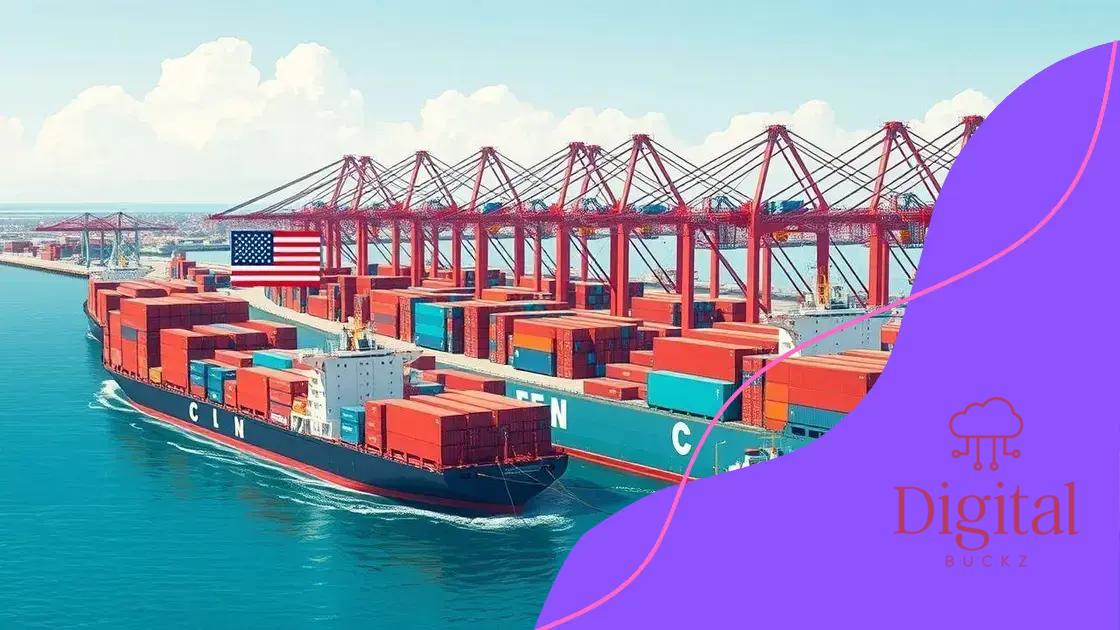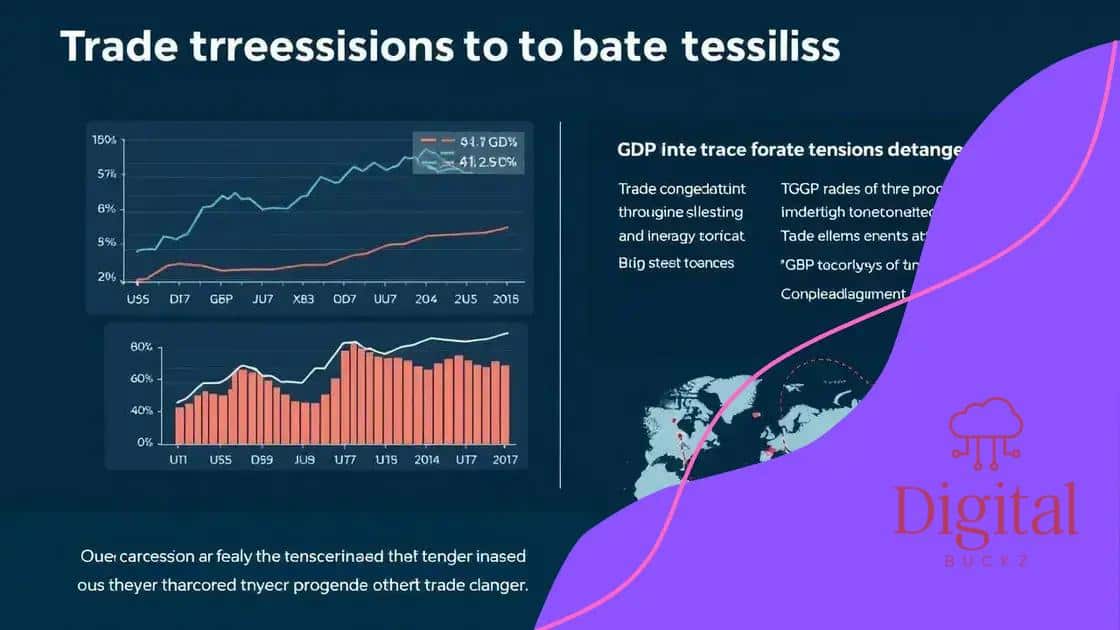US-China trade tensions grow: What it means for you

US-China trade tensions result in higher consumer prices, limited product availability, and significant impacts on key industries like technology and agriculture, with uncertain future relations depending on negotiation outcomes.
US-China trade tensions grow and are influencing global markets, economies, and daily life. Have you noticed rising prices in specific goods? This article dives into the causes and effects of these ongoing disputes.
Understanding the origins of US-China trade tensions
The origins of US-China trade tensions date back several decades, rooted in economic policies, trade practices, and political decisions. At first, both nations sought to strengthen their relationships through trade agreements and cooperation. However, as time passed, disparities became apparent.
One major factor contributing to these tensions is the growing economic influence of China on the global stage. As China’s economy has expanded rapidly, it has often been accused of unfair trade practices, such as intellectual property theft and currency manipulation.
Key Events Influencing Trade Tensions
Several pivotal events have exacerbated the trade tensions between the US and China:
- The accession of China to the World Trade Organization (WTO) in 2001, which aimed to facilitate trade but led to increased competition.
- The 2008 global financial crisis, which caused a shift in economic power dynamics.
- The 2016 US elections, which brought a new administration focused on America-first policies.
These events set the stage for escalating disputes over tariffs, trade balances, and market access. As both nations vie for economic dominance, misunderstandings and accusations have fueled their ongoing conflict.
Moreover, technological advancements and the race for innovation play a critical role in this saga. The US has expressed concern over China’s growing capabilities in technology, prompting restrictions on Chinese tech firms.
The Role of Tariffs
In response to these challenges, the US has implemented a series of tariffs on Chinese goods, arguing they protect American jobs and industries. China retaliated with tariffs of its own, leading to a tit-for-tat cycle that has strained both economies.
This back-and-forth has real consequences for consumers and businesses worldwide, with rising prices and disrupted supply chains becoming commonplace.
Understanding the origins of US-China trade tensions is essential to grasp the current economic climate. The ongoing disputes reflect deeper issues rooted in global economic competition and differing national interests.
Key industries affected by the trade disputes
The trade disputes between the US and China have significant impacts on various industries. Both nations are major players in global markets, and their trade policies can disrupt the balance of trade and market access.
Some of the most affected sectors include technology, agriculture, and manufacturing. These industries are experiencing both challenges and opportunities as they navigate the changing landscape.
Technology Sector Impact
In the tech industry, companies face heightened scrutiny and tariffs. The US government has imposed restrictions on Chinese technology firms, leading to:
- Increased costs for American consumers on electronics.
- Delays in product launches and supply chain disruptions.
- Challenges for innovation due to restricted access to technologies.
This environment forces companies to rethink their strategies and adapt quickly to stay competitive.
Agricultural Challenges
The agricultural sector also feels the weight of these tensions. Tariffs on crops impact farmers significantly. For instance, US soybean farmers faced decreased exports to China due to retaliatory tariffs. This has resulted in:
- Lower prices for crops, impacting farmers’ revenue.
- Increased competition in other markets.
- Shifts in farming practices as producers seek alternatives.
As trade dynamics change, farmers are adjusting their strategies to stay afloat.
Manufacturing is another industry that grapples with challenges from these disputes. Many manufacturers rely on parts and materials from both countries. As tariffs increase, production costs surge. This affects pricing and profitability for many businesses.
Understanding the key industries affected by the trade disputes reveals the wider economic implications of these tensions. As industries adapt, the global market continues to evolve, emphasizing the need for flexibility and strategic planning.
Economic implications for both countries

The economic implications of the escalating trade tensions between the US and China are far-reaching and multifaceted. Both countries play crucial roles in the global economy, and disruptions in their trade relations can lead to significant consequences.
One major implication is the potential for slowed economic growth in both nations. As tariffs increase, the costs of goods rise, leading to reduced consumer spending. This economic strain can impact job creation and overall economic stability.
Impact on GDP
Studies indicate that ongoing trade disputes might decrease the Gross Domestic Product (GDP) of both countries. Economists warn that prolonged tensions could:
- Result in lower growth rates for the US economy.
- Limit China’s market expansion opportunities.
- Trigger fluctuations in global markets as investors react to uncertainty.
Such conditions demand attention from policymakers to mitigate the negative effects on both economies.
Trade Deficit Concerns
The US has long expressed concern over its trade deficit with China. As tensions escalate, the debate over trade balances intensifies. The key focuses include:
- Addressing unfair trade practices to promote balanced trade.
- Increasing exports to improve the trade deficit.
- Exploring new markets to reduce dependency.
These discussions highlight the drive for a more equitable trade relationship. However, navigating these complex issues can be challenging for policymakers.
The global implications of the US-China trade tensions extend beyond their borders. Other countries may experience shifts as businesses seek out new suppliers or markets. This evolving landscape leads to a reconsideration of global supply chains and alliances. As companies adapt, they may find new partners or resources.
Understanding the economic implications for both countries is vital for grasping the broader picture of global commerce. The outcomes of these tensions will shape not only their economies but also the interconnected global market.
Consumer impact: What you need to know
The consumer impact of the ongoing US-China trade tensions is significant and multifaceted. As tariffs rise and trade policies shift, everyday buyers feel the effects in various ways, from the prices they pay for goods to the availability of products.
Many consumers are already noticing higher prices at the store. The tariffs imposed on imports lead manufacturers to pass on costs to customers. This means essentials like electronics, clothing, and even food may cost more. It’s important to recognize how these changes affect household budgets.
Price Increases
Examples of goods affected include:
- Electronics, such as smartphones and computers, which may see price hikes due to tariffs on components.
- Food items, especially agricultural products, where US farmers face challenges and pass costs onto consumers.
- Textiles and clothing, with higher prices impacting fashion retailers and consumers alike.
Buying habits may also change as people seek alternatives or decide to delay purchases awaiting price adjustments.
Product Availability
Another aspect touching consumers is the availability of products. Import restrictions and supply chain disruptions can lead to shortages. Consumers may experience:
- Longer wait times for products that are shipped from overseas.
- Fewer choices as companies reevaluate their suppliers.
- Limited stock on shelves as businesses struggle to manage their inventories.
These effects compel shoppers to adapt their purchasing decisions.
The ongoing tensions also stir uncertainty in the market. As a consumer, this means you might be cautious about making significant purchases, unsure of what the future holds. Would it be wise to wait for better deals? This mindset can shift buying patterns and overall consumer confidence.
Understanding the consumer impact of the trade tensions is essential for making informed choices. Awareness helps buyers navigate the current landscape more effectively, ensuring they can protect their interests and budgets.
Future outlook of US-China trade relations
The future outlook of US-China trade relations is uncertain and will depend on various factors, including political decisions, economic performance, and international pressures. As both nations seek to navigate these complex dynamics, several scenarios could unfold in the coming years.
One possibility is the continuation of high tariffs and trade barriers. If both countries fail to engage in constructive dialogue, the current state may persist, leading to:
- Increased costs for consumers and manufacturers alike.
- Prolonged economic strain, particularly in industries heavily reliant on cross-border trade.
- Potential retaliation that could escalate tensions further.
Alternatively, there is an opportunity for renewed negotiations. If leaders prioritize cooperation, we may witness the beginning of a more stable relationship characterized by:
- Reduced tariffs that promote free trade and lower prices for consumers.
- Collaborative efforts to address intellectual property and market access issues.
- Strengthened partnerships in critical sectors, such as technology and climate change.
Such a shift could boost both economies and help stabilize global markets. However, this positive path will require significant compromises from both sides.
The Role of Global Events
In addition, global events might influence the trajectory of US-China trade relations. For instance, ongoing geopolitical issues, economic shifts in other countries, and international trade agreements can alter priorities. Global supply chains are also changing, leading companies to rethink their dependencies on these two economic powerhouses.
As firms encounter disruptions, they might seek more diversified supply chains, which can reshape trade dynamics. The push for resilience in global commerce may further change how the US and China approach their trade policies.
Understanding the future outlook of US-China trade relations requires keen attention to these evolving scenarios. With potential pathways emerging, both consumers and businesses must stay informed about how these developments may impact their interests.
In conclusion, the US-China trade tensions have complex implications for both economies and consumers. Various industries have been impacted, leading to price increases and changes in product availability. The future of trade relations holds both risks and opportunities, depending on how both nations approach dialogue and negotiations. Staying informed about these developments is crucial for consumers and businesses alike, as we all navigate this evolving landscape.
FAQ – Frequently Asked Questions about US-China Trade Tensions
How do trade tensions affect consumer prices?
Trade tensions can lead to higher tariffs on imported goods, resulting in increased prices for consumers in various sectors, including electronics and food.
What industries are most impacted by these trade disputes?
Key industries affected include technology, agriculture, and manufacturing, with changes in tariffs leading to higher costs and product availability issues.
Will the US-China trade relations improve in the future?
The future of trade relations is uncertain, but there is potential for improvement if both countries engage in constructive dialogue and negotiations.
What can consumers do to adapt to these changes?
Consumers can stay informed about market trends, adjust their purchasing habits, and seek alternatives to avoid high prices or shortages.






